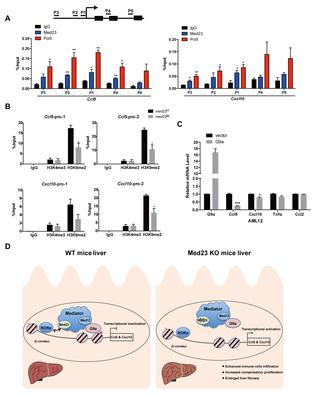当前位置:
X-MOL 学术
›
PLOS Biol.
›
论文详情
Our official English website, www.x-mol.net, welcomes your
feedback! (Note: you will need to create a separate account there.)
Mediator MED23 regulates inflammatory responses and liver fibrosis.
PLOS Biology ( IF 7.8 ) Pub Date : 2019-12-05 , DOI: 10.1371/journal.pbio.3000563 Zhichao Wang 1 , Dan Cao 2 , Chonghui Li 2 , Lihua Min 2 , Gang Wang 1
PLOS Biology ( IF 7.8 ) Pub Date : 2019-12-05 , DOI: 10.1371/journal.pbio.3000563 Zhichao Wang 1 , Dan Cao 2 , Chonghui Li 2 , Lihua Min 2 , Gang Wang 1
Affiliation

|
Liver fibrosis, often associated with cirrhosis and hepatocellular carcinomas, is characterized by hepatic damage, an inflammatory response, and hepatic stellate cell (HSC) activation, although the underlying mechanisms are largely unknown. Here, we show that the transcriptional Mediator complex subunit 23 (MED23) participates in the development of experimental liver fibrosis. Compared with their control littermates, mice with hepatic Med23 deletion exhibited aggravated carbon tetrachloride (CCl4)-induced liver fibrosis, with enhanced chemokine production and inflammatory infiltration as well as increased hepatocyte regeneration. Mechanistically, the orphan nuclear receptor RAR-related orphan receptor alpha (RORα) activates the expression of the liver fibrosis-related chemokines C-C motif chemokine ligand 5 (CCL5) and C-X-C motif chemokine ligand 10 (CXCL10), which is suppressed by the Mediator subunit MED23. We further found that the inhibition of Ccl5 and Cxcl10 expression by MED23 likely occurs because of G9a (also known as euchromatic histone-lysine N-methyltransferase 2 [EHMT2])-mediated H3K9 dimethylation of the target promoters. Collectively, these findings reveal hepatic MED23 as a key modulator of chemokine production and inflammatory responses and define the MED23-CCL5/CXCL10 axis as a potential target for clinical intervention in liver fibrosis.
中文翻译:

介质MED23调节炎症反应和肝纤维化。
肝纤维化通常与肝硬化和肝细胞癌相关,其特征是肝损害,炎症反应和肝星状细胞(HSC)活化,尽管其潜在机制尚不清楚。在这里,我们表明转录介体复合物亚基23(MED23)参与实验性肝纤维化的发展。与对照组同窝仔相比,肝Med23缺失的小鼠表现出加剧的四氯化碳(CCl4)诱导的肝纤维化,增加了趋化因子的产生和炎性浸润,并增加了肝细胞的再生。机械上,孤儿核受体RAR相关孤儿受体α(RORα)激活肝纤维化相关趋化因子CC基序趋化因子配体5(CCL5)和CXC基序趋化因子配体10(CXCL10)的表达,其被介体MED23亚基抑制。我们进一步发现,MED23对Ccl5和Cxcl10表达的抑制可能是由于G9a(也称为常染色体组蛋白赖氨酸N-甲基转移酶2 [EHMT2])介导的目标启动子H3K9甲基化。这些发现共同表明,肝MED23是趋化因子产生和炎症反应的关键调节剂,并将MED23-CCL5 / CXCL10轴定义为临床干预肝纤维化的潜在靶标。我们进一步发现,MED23对Ccl5和Cxcl10表达的抑制可能是由于G9a(也称为常染色体组蛋白赖氨酸N-甲基转移酶2 [EHMT2])介导的目标启动子H3K9甲基化。这些发现共同表明,肝MED23是趋化因子产生和炎症反应的关键调节剂,并将MED23-CCL5 / CXCL10轴定义为临床干预肝纤维化的潜在靶标。我们进一步发现,MED23对Ccl5和Cxcl10表达的抑制可能是由于G9a(也称为常染色体组蛋白赖氨酸N-甲基转移酶2 [EHMT2])介导的目标启动子H3K9甲基化。这些发现共同表明,肝MED23是趋化因子产生和炎症反应的关键调节剂,并将MED23-CCL5 / CXCL10轴定义为临床干预肝纤维化的潜在靶标。
更新日期:2019-12-06
中文翻译:

介质MED23调节炎症反应和肝纤维化。
肝纤维化通常与肝硬化和肝细胞癌相关,其特征是肝损害,炎症反应和肝星状细胞(HSC)活化,尽管其潜在机制尚不清楚。在这里,我们表明转录介体复合物亚基23(MED23)参与实验性肝纤维化的发展。与对照组同窝仔相比,肝Med23缺失的小鼠表现出加剧的四氯化碳(CCl4)诱导的肝纤维化,增加了趋化因子的产生和炎性浸润,并增加了肝细胞的再生。机械上,孤儿核受体RAR相关孤儿受体α(RORα)激活肝纤维化相关趋化因子CC基序趋化因子配体5(CCL5)和CXC基序趋化因子配体10(CXCL10)的表达,其被介体MED23亚基抑制。我们进一步发现,MED23对Ccl5和Cxcl10表达的抑制可能是由于G9a(也称为常染色体组蛋白赖氨酸N-甲基转移酶2 [EHMT2])介导的目标启动子H3K9甲基化。这些发现共同表明,肝MED23是趋化因子产生和炎症反应的关键调节剂,并将MED23-CCL5 / CXCL10轴定义为临床干预肝纤维化的潜在靶标。我们进一步发现,MED23对Ccl5和Cxcl10表达的抑制可能是由于G9a(也称为常染色体组蛋白赖氨酸N-甲基转移酶2 [EHMT2])介导的目标启动子H3K9甲基化。这些发现共同表明,肝MED23是趋化因子产生和炎症反应的关键调节剂,并将MED23-CCL5 / CXCL10轴定义为临床干预肝纤维化的潜在靶标。我们进一步发现,MED23对Ccl5和Cxcl10表达的抑制可能是由于G9a(也称为常染色体组蛋白赖氨酸N-甲基转移酶2 [EHMT2])介导的目标启动子H3K9甲基化。这些发现共同表明,肝MED23是趋化因子产生和炎症反应的关键调节剂,并将MED23-CCL5 / CXCL10轴定义为临床干预肝纤维化的潜在靶标。









































 京公网安备 11010802027423号
京公网安备 11010802027423号